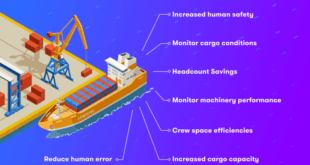Quantum technology (QT) applies quantum mechanical properties such as quantum entanglement, quantum superposition, and No-cloning theorem to quantum systems such as atoms, ions, electrons, photons, or molecules. Quantum bit is the basic unit of quantum information. Whereas in a classical system, a bit is either in one state or …
Read More »US DOD’s DIU accelerating DOD adoption of commercial technologies, transformation of military capacity and capability and strengthen the national security innovation base
Historically and during the cold war military technology programs drove many commercial successes like Nuclear power, GPS, Internet, Computers, Jet Engines, semiconductor and integrated circuits, and these were driven by Department of Defense’s comprehensive and well-resourced investment plans. The internet grew out of a military research project. Global Positioning System …
Read More »Autonomous shipping or Autonomous shipping or Maritime Autonomous Surface Ships (MASS) technologies
Autonomous ships refer to the ships that are remote built ships where operations are performed by remote control mechanism. These operations are operated by the humans located at the shore. Autonomous requires high quality systems and reliable communication system which work with the assistance of connectivity, control algorism and sensor …
Read More »Global air pollution threat requires IoT-based Air quality monitoring solutions
Atmospheric conditions continue to deteriorate each year due to the growth of civilization and increasing unclean emissions from industries and automobiles. Although air is an indispensable resource for life, many people are indifferent to the severity of air pollution or have only recently recognized the problem. According to the …
Read More »New processes Implementation and improvements
A process can be defined as a sequence of steps that produce the desired outcome. Defined and documented processes also ensure consistent outcomes. Logbooks are completed the same way, no matter who makes the entry. Invoices are processed correctly and completely, regardless of who handles them. Continuous improvement is an ongoing effort …
Read More »USSOCOM Special Operations Forces technology requirements to support counterterrorism, crisis response to high-end conflicts
Special operations (S.O.) are military, law enforcement or intelligence operations that are “special” or unconventional and carried out by dedicated special forces and other special operations forces units using unconventional methods and resources. Special operations may be performed independently, or in conjunction with conventional military operations. The primary goal is …
Read More »AI in Project Management
A project comprises a series of tasks designed to meet a specific objective. It can be developing a new product/service, constructing a bridge or building, house renovation, upgrading the data system, implementing new business, etc. All business people want to find a way to manage their projects effectively to boost …
Read More »US Military, the world’s largest polluter is implementing energy security strategy reducing future resource risk and increasing mission assurance
In the domain of defense, energy has the potential to be both an enabler of hard power but also, via denial, arguably itself to be a weapon of war. Energy enables nearly everything the military does, and the primary objective is mission assurance and decisive advantage on the battlefield. Energy security …
Read More »DARPA ICEMAN to protect Military pilots from cognitive degradation from operational and High power microwave weapons
Military pilots often report cognitive performance challenges during flight operations. Many have reported experiences with spatial disorientation (SD), in which the pilot’s perception of aircraft position, motion, altitude, or attitude does not correspond to reality. SD has posed a significant problem to military pilots and continues to be a challenge today. …
Read More »Green Energetic Materials and Munitions technologies with enhanced environmental and occupational safety
Energetic materials and munitions are used across DoD in mission critical applications such as rockets, missiles, ammunition, and pyrotechnic devices. In these applications, energetic materials and munitions must perform as designed to ensure success in both training and combat operations. In these applications, energetic materials and munitions must perform …
Read More » International Defense Security & Technology Your trusted Source for News, Research and Analysis
International Defense Security & Technology Your trusted Source for News, Research and Analysis





